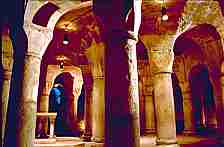 |
|
Scripts and Hands
(2)
|
| In the period which we refer to as the Dark Ages, a term which describes our ignorance of the era rather than any particular horribleness, literacy was confined to the Christian church in many places. Missionising monasteries were nodes of literacy, connected to the literate heritage of Rome and to each other, but embattled and surrounded by a range of competing cultures and peoples. They wrote to preserve the culture of Christianity, and what they wrote were the significant texts of the Christian church, as well as important texts from the Classical Roman literate tradition, because these displayed for them the tools of their trade; the Latin language and the means of reproducing it in writing. |
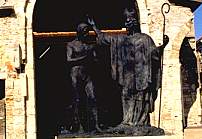 |
Modern statue of the baptism of Clovis, supposedly on the very spot where it took place, in Rheims; a coup for the early Christian church in France. |
| Merovingian crypt under the Benedictine abbey in Dijon; one of the earlier relics of Christianity in France. |
|
| From before the 8th century or so, far more manuscripts have been lost than survive. Not surprising really, what with the long history of invasion and pillage, fires in the library, rising damp and insects, and periodic rounds of deliberate destruction to provide for more correct and orthodox texts. Most works of early Christian fathers of the church are known only from much later copies. We do not have St Jerome's autograph anywhere. Nevertheless, there appears to be an underlying pattern of certain monasteries, or regional groups of monasteries, developing their own distinctive house styles. The scripts employed all over western Christendom were based on New Roman cursive, the general working style of the late Roman Empire, but they evolved distinct local characteristics. |
 |
Sample from a 7th century Gallican lectionary which originally belonged to the abbey of Luxueil (Paris, Bibliothèque Nationale, fonds latin 9427, f.143). |
| For example, the script above is known as Luxeuil minuscule, as it was particularly associated with the abbey of Luxeuil, although in a more general sense it is a form of Merovingian minuscule. |
 |
Sample comes from a codex of c. 800 from the abbey of Corbie (St Petersberg, Imperial Library, F.XIV). |
| Similarly, the script of the example above is known as Corbie a-b, becuuse it was associated with the abbey of Corbie, and the a and b of the alphabet were distinctive and strange. It could also be classed as a variant of Merovingian minuscule. |
| Writing at this stage was not done purely for communication. It was a precious artifact of the church; a cultural object. The style of writing was mannered and distinctive, making heavy use of ligatures and minimal or erratic use of punctuation in many cases. The divergences of style between the various monasteries no doubt related to their existence as isolated nodes in a large empty landscape which was periodically invaded by people whose intentions were not kindly. The monks of Luxeuil and Corbie, and Canterbury and Jarrow and Kells (or Iona), and no doubt other places where the evidence has been lost, had a strong script prototype to follow. Divergences from the prototype may have been partly caused by the fact that writing at this time was a rare skill, and some scribes were more competent than others. |
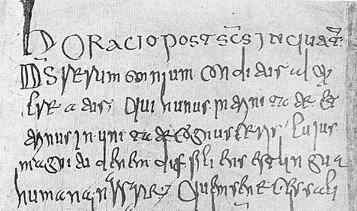 |
The example comes from a 8th century missal which had belonged to the abbey of Fleury |
I sincerely believe that the example of Merovingian minuscule above was written by a scribe who was so preoccupied with his ligatures that he was unable to concentrate on the text of what he was writing. |
| In history, things happen, and we are left with a filleted and compacted body of evidence for processes that occur over time. The abbey of Luxeuil was sacked by the Vikings and their unique script disappeared, except for those surviving samples that were perhaps housed somewhere else at the time. The church was not immune from the violence and social upheaval that was occurring all around. The most distinctive pre-Carolingian scripts came from areas that had some degree of separation. Spain was invaded by Muslims from the south, leaving Christian areas but also Mozarabic communities, Christian groups living in Muslim areas. The Visigothic script retained a regional character into the 11th century; an ethnic and religious symbol in its own right. |
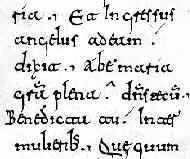 |
This example comes from a 10th century volume from the monastery of San Domingo at Silos, Spain (British Library, add. ms. 30844). By permission of the British Library. |
| Charlemagne conquered the Lombardic north of Italy, taking that area into the general Frankish domain of culture, but Lombardic dominions in the south of Italy developed their own distinctive script, known as Beneventan minuscule, particularly associated with the abbey of Montecassino. This script lasted until the 13th century. |
 |
| This segment comes from a late 11th century exultet roll from Italy, formerly in the abbey of Montecassino (British Library, add ms 30337), by permission of the British Library. |
| In Britain, and perhaps particularly in Ireland, far to the west of everywhere and over the water, a whole distinctive family of scripts developed. In these parts the natives had no ongoing conversations with the speakers of Latin or its various creole descendants that developed into the Romance languages of Europe, but learned their Latin as a second, and largely written (but definitely not dead), language. Their writing was very formalised, with proper word spacing and often elaborate forms of punctuation. It was written as a communications system. The insular minuscule family of scripts is somehow easily recognisable wherever it appears, even though it comes in a variety of styles; round, square, pointed, but always seriously elegant. And it did go to other places. Anglo-Saxon religious foundations in Germany and Irish foundations in Switzerland mean that this distinctive style can turn up in those places, even in the middle of a text written by other scribes in other hands. Here there is a great capacity for the individual hand of the scribe to differ from an exemplar, even when the underlying writing system is similar. |
 |
The big fat writing of the Book of Kells (Trinity College, Dublin, MS A. I. (58)). |
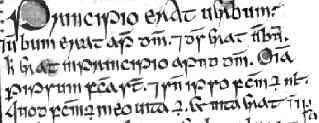 |
The beginning of the Gospel of St John from The Gospels of Maelbrigte, a codex of 1138 from Armagh, Ireland (British Library, Harley 1802, f.128). By permission of the British Library. |
| The insular system lasted for centuries, particularly in Ireland where it eventually no longer was a signifier just of the Catholic church, but of the ethnicity of the people. Any one example of this script may not look intuitively just like another. This is where you have to start taking the letters apart; work out which is s and which is r for example. Insular minuscule is probably about the only one of the so-called National Hands that really fits the name, but that could get us into Irish politics, so perhaps we should just throw that old terminology away. Instead, just marvel at how many styles of individual hands can be accommodated with a designated script. |
| In the more central areas of continental western Europe, things got rather more confused. The pattern of writing centres was disrupted by such events as Viking raids or Saracen incursions, not to mention Charlemagne and his Frankish followers tramping all over the place. The literate monks got shunted around a bit, and so did their books. Exemplars from one monastery may not have looked exactly like the ones from another and styles mingled along with the books and their writers. Some monasteries in Germany developed a new style of writing which is, at least to our eyes, more legible than some of the Merovingian styles. The whole Merovingian/Germanic/Lombardic complex is difficult to categorise neatly into defined script styles. Let us say that there are lots of hands, but not so many clearly defined scripts. That makes legibility difficult for us, but it also made it difficult for them, and they had reasons for wanting to ensure the accuracy and integrity of their texts, as they were the basis for their whole Christian belief system. |
|
 previous page previous page |
 Reading Manuscripts Reading Manuscripts |
 Why Read It?
Why Read It? |
|
 |
 |
 |
 |
 |
 |
 |
 |

